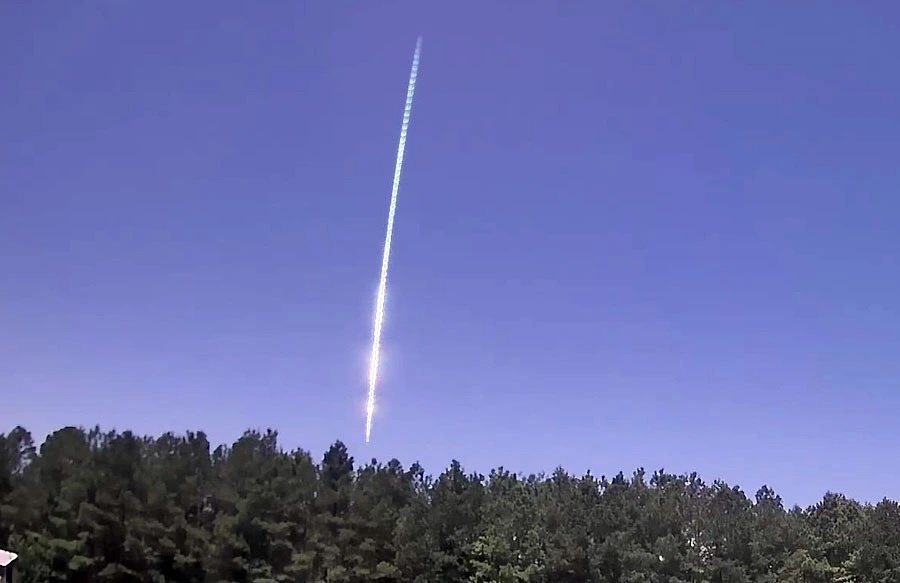29.06.2025

This frame capture shows the daylight fireball that blazed over the Southeast U.S. on June 26th.
Ed Albin / AllSky7 Global Network
On June 26th at 12:25 p.m. EDT, a spectacular daytime fireball flared over the southeastern U.S. before disintegrating in a thunderous explosion southeast of Atlanta, Georgia. The American Meteor Society (AMS) received more than 200 reports from 20 states of the brilliant, midday object as it sped from north-northeast to south-southwest over the state.
"Many instruments recorded the fall, including National Oceanic and Atmospheric Administration satellites, and Doppler radars, and even some of our AllSky7 cameras," says Mike Hankey, AMS Operations Manager. The two videos that follow were made by Ed Albin of the AllSky7 Global Network. For more video clips check out this Atlanta News First Report.
Bill Cooke, lead of NASA's Meteoroid Environments Office said in a statement that the fireball was traveling at approximately 30,000 miles per hour and broke up at an altitude of 27 miles above West Forest, Georgia. Cooke estimated that the meteoroid was about 3 feet wide and weighed more than a ton. According to calculations done by the Center for Near-Earth Object Studies(CNEOS), the object struck the atmosphere with a total impact energy of nearly half a kiloton of TNT!
Rapid atmospheric entry shattered the meteoroid, which created a shock wave that rattled windows and produced loud booms, which some observers thought came from an earthquake. Many reported thunder and rumbling that lasted for 10-15 seconds. While the vast majority of incoming meteoroids are incinerated and reduced to dust, a tiny percentage — like the Georgia fall — find their way to the ground as meteorites. Most originate in exploding fireballs known as bolides.

Courtesy of Mike Hankey

CSU, CIRA & NOAA
Not long after the sonic boom, someone in McDonough, Georgia, located about 30 miles south of Atlanta, reported that a golf-ball-size rock had punched a hole in their roof, penetrated the ceiling, and slammed into the floor. Fortunately, no one was hurt.
Meteorite hunters soon arrived in the area looking for charcoal briquettes. This term, sometimes used to describe newly-fallen meteorites, refers to the fresh, black fusion crust (typically 1-2 millimeters thick) that forms around fragments during their brief, heated flight through the atmosphere. If you join the hunt, you'll be looking for out-of-the-ordinary black rocks on streets, parking lots, fields, and in forests.

Steven Dixey

Steven Dixey
Steven Dixey of Atlanta got to the scene on June 26th before a torrential downpour and recovered two beautiful stony meteorites from the fall, both of which shattered into pieces upon impact. He found several more on June 27th. Several of the fragments exhibit stunning flowlines from molten rock that flowed across their surfaces. Such features are highly prized by collectors as they provide a freeze-frame of the space rock's tortuous transition from outer space to planet Earth. While it's still too early to know the specific type of meteorite that fell, my personal hunch is a low-metal ordinary chondrite. Time and testing will tell.
I've read and seen videos suggesting that the new visitor could be related to the Beta Taurid meteor shower, a daylight shower active from late June through early July that originates from Comet 2P/Encke. I would caution jumping to that conclusion too soon, because there's no conclusive evidence yet for any comet-related meteorites. Most are asteroid fragments.

Roberto Vargas

Steven Dixey
Nearly 50 tons of meteoric material enters Earth's atmosphere every day, mostly in the form of dust. Pieces big enough to survive and strike the ground as meteorites are rare. Rarer yet is seeing one fall and being able to pick up the pieces!
Quelle: Sky&Telescope
